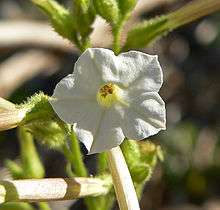Nicotiana attenuata
| Coyote tobacco | |
|---|---|
 | |
| Scientific classification | |
| Kingdom: | Plantae |
| (unranked): | Angiosperms |
| (unranked): | Eudicots |
| (unranked): | Asterids |
| Order: | Solanales |
| Family: | Solanaceae |
| Genus: | Nicotiana |
| Species: | N. attenuata |
| Binomial name | |
| Nicotiana attenuata Torr. ex S.Watson | |
Nicotiana attenuata is a species of wild tobacco known by the common name coyote tobacco. It is native to western North America from British Columbia to Texas and northern Mexico, where it grows in many types of habitat. It is a glandular and sparsely hairy annual herb exceeding a meter in maximum height. The leaf blades may be 10 centimetres (4 in) long, the lower ones oval and the upper narrower in shape, and are borne on petioles. The inflorescence bears several flowers with pinkish or greenish white tubular throats 2 to 3 centimetres (4⁄5 to 1 1⁄5 in) long, their bases enclosed in pointed sepals. The flower face has five mostly white lobes. The fruit is a capsule about 1 centimetre (1⁄2 in) long.
When this tobacco is eaten by the larvae of the tobacco hornworm (Manduca sexta) the plant emits green leaf volatiles that attract Geocoris bugs, which are predators of the worm.[1]
Natural History
Introduction
Nicotiana attenuata has been utilized as an ecological model species since 1994,[2] thanks in large part to its diverse interactions with a host of different plants, insects and microorganisms in its native habitat. Work at the Max Planck Institute for Chemical Ecology in Jena, Germany, has been instrumental in integrating a toolbox of genomic, ecological, and analytical tools alongside field work in the Great Basin Desert in order to study the interactions of N. attenuata in its native environment.
Genome
N. attenuata’s genome is ~2.26 Gb long,[3] significantly more than the plant model species Arabidopsis thaliana. Preferential gene retention after a genome-wide duplication event in the genus Nicotiana partially accounts for this large size, which is roughly twice that of N. obtusifolia (~1.23 Gb), a closely related species.[4]
Uses
This plant was used for a great variety of medicinal purposes by many Native American groups, and was smoked ceremonially by the Hopi, Apache, Navajo, Paiute, and other groups.[5]
Among the Zuni people, the smoke is blown over the body to reduce the throbbing from rattlesnake bite.[6] It is also smoked ceremonially among them.[7]
- Nicotiana attenuata plant grown at a field site in Utah
 Manduca feeding on Nicotiana attenuata
Manduca feeding on Nicotiana attenuata Coyote tobacco forming fruit capsules
Coyote tobacco forming fruit capsules
References
- ↑ Bhanoo, S. From a Desert Plant, a Scented Cry for Help. New York Times August 30, 2010.
- ↑ Baldwin, I. T.; Staszak-Kozinski, L.; Davidson, R. (1994-09-01). "Up in smoke: I. Smoke-derived germination cues for postfire annual,Nicotiana attenuata torr. Ex. Watson". Journal of Chemical Ecology. 20 (9): 2345–2371. ISSN 0098-0331. PMID 24242811. doi:10.1007/BF02033207.
- ↑ "Nicotiana attenuata Data Hub - The resource for the coyote tobacco genome". nadh.ice.mpg.de. Retrieved 2017-01-12.
- ↑ Zhou, Wenwu; Brockmöller, Thomas; Ling, Zhihao; Omdahl, Ashton; Baldwin, Ian T.; Xu, Shuqing (2016-11-04). "Evolution of herbivore-induced early defense signaling was shaped by genome-wide duplications in Nicotiana". eLife. 5: e19531. ISSN 2050-084X. PMC 5115867
 . PMID 27813478. doi:10.7554/eLife.19531.
. PMID 27813478. doi:10.7554/eLife.19531. - ↑ Ethnobotany
- ↑ Stevenson, Matilda Coxe 1915 Ethnobotany of the Zuni Indians. SI-BAE Annual Report #30 (p. 54)
- ↑ Stevenson, p.95
External links
| Wikimedia Commons has media related to Nicotiana attenuata. |
- Jepson Manual Treatment
- USDA Plants Profile
- Calflora Database: Nicotiana attenuata (coyote tobacco)
- GRIN Species Profile
- Photo gallery